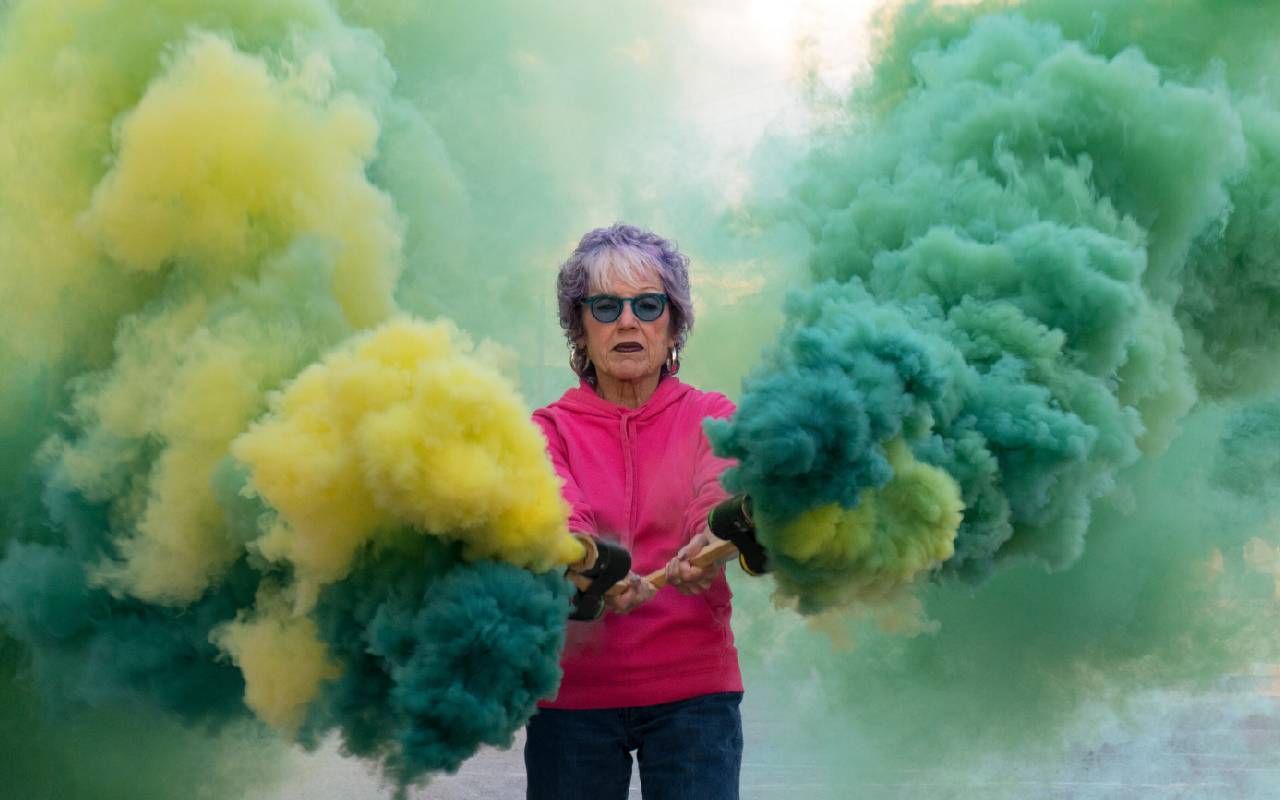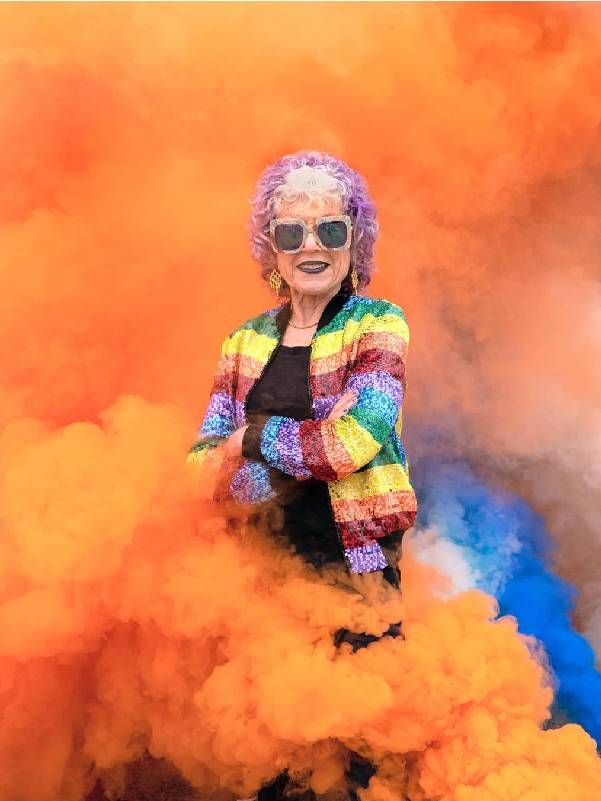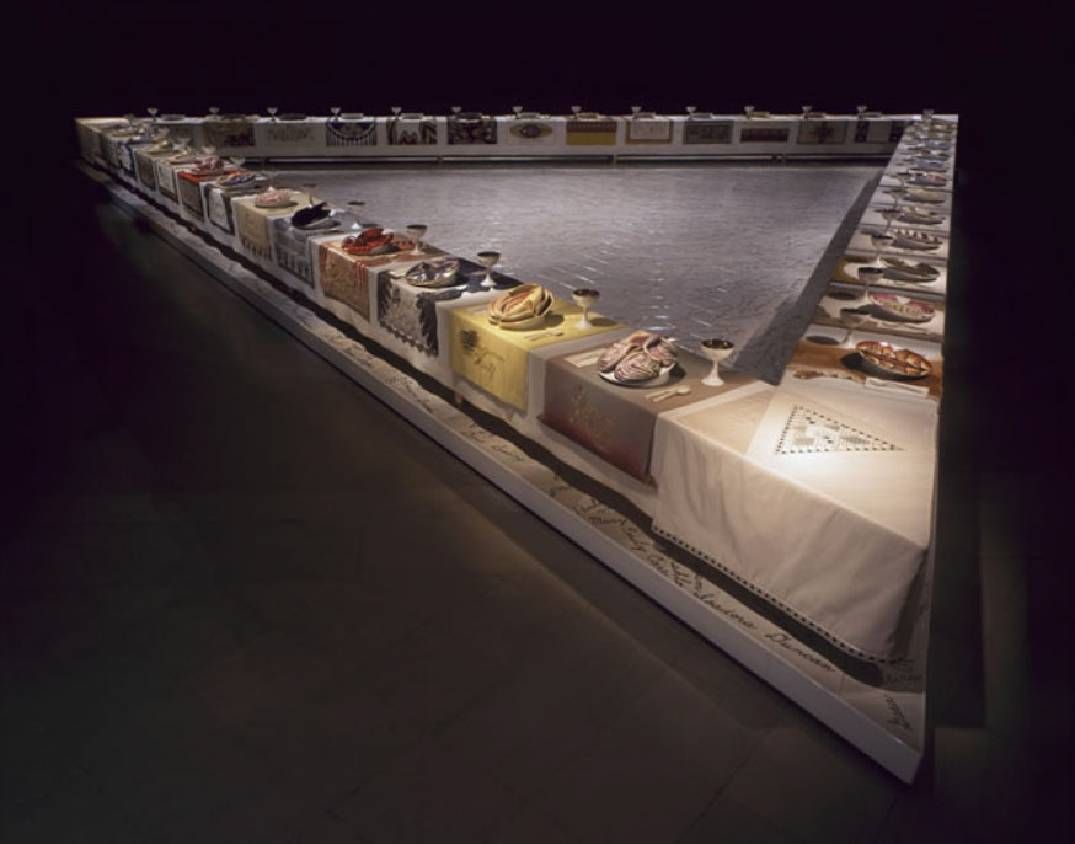Feminist Artist Judy Chicago Whose History is Herstory
At 84, Judy Chicago is having a turn in the spotlight and 'modified her expectations' for herself while continuing to pursue her 'burning desire to make art'
The "herstory" of groundbreaking, feminist, multi-hyphenated artist Judy Chicago spans six decades of boundary-pushing creative activity in a kaleidoscope of media — painting, printmaking, ceramics, quilting, tapestry, embroidery, stained glass, even pigmented smoke and auto body spray-painting.
Indeed, after college, Chicago went to auto body school to learn to spray paint. She was the lone woman among 250 men in the class, a symbolic start to a career in which she often uses skills acquired in a male-dominated world and reinvents them to tell women's stories. Spray-painting became one of the hallmarks of her work.

In an interview by email with Next Avenue, Chicago spoke of her enthusiasm for this technique, saying, "I LOVE to spray-paint. I have sprayed automotive lacquers and enamel; acrylic; fabric paint; and china paint; and more recently, glass paint, which was an incredible challenge and required several years of experimentation."
"Women's art has rarely been seen as a whole, it has a consistent way of sidelining women artists, including me."
"Herstory" is also the name of the most recent survey of her life's work at the New Museum through March 3rd, the first one ever held in New York City. In 2021, I saw the very first retrospective of her long career at the De Young Museum in San Francisco.
"Women's art has rarely been seen as a whole," she lamented in her most recent autobiography, "The Flowering," adding that "it has a consistent way of sidelining women artists, including me."
But with these two bicoastal retrospectives, she's stepped firmly out of the sidelines. The De Young exhibition, she says, "was a revelation to many viewers as it was the first time that they were able to see a broad survey of my oeuvre."
A Well-Deserved Turn in the Spotlight
The exhibits show off Chicago's work as a dazzling and witty medley of vibrant colors, anatomical shapes, sensual and surreal imagery, political passion and materials manipulated in entirely original ways. Her dedication to women's freedom and her anger at any form of oppression steam off the walls. Like much political art from Picasso's "Guernica" to Faith Ringgold's Sixties' posters to Ai Weiwei's installations, Chicago's work unabashedly and unapologetically makes a statement that women's lives matter.
At 84, and a 5'1" powerhouse, Chicago is having a well-deserved turn in the spotlight. Besides the museum retrospectives, she's currently featured in an ad for Christian Dior, one of the New Museum show's sponsors, rocking cornflower blue sunglasses and smoky purple hair, nails and lipstick. In an alternate lifetime, she could have been the lead singer in a punk band.
A Lifelong Feminist Vision
Chicago has been articulating her feminist vision and pushing the envelope since the 1970s when she founded the first feminist art program at California State University at Fresno. Her goal then and ever since has been to create a women's art movement to match the women's liberation movement and agitate for social justice and political change.
She explains, "My father taught me that it was my OBLIGATION to make a contribution to a better world, a mandate that has shaped my life and work, that and a deep commitment to equity for everyone who shares this planet — both human and non-human. I pushed myself tirelessly for almost six decades to accomplish this."

She was born Judy Cohen, then became Gerowitz when she married her first husband, Jerry. In 1970 she changed her name to Judy Chicago. The name was a feminist statement and a nod to the "Windy City" accent she retained from her hometown and that city's macho energy.
The shadow of death darkened her early years — her beloved father died when she was just 13, and Jerry Gerowitz died in a fatal car crash early in their marriage. Her second marriage to a fellow artist, Lloyd Hamrol, lasted rockily from 1965 to 1979 as he turned out to be competitive and unfaithful, according to her memoir. In 1985, she made a third, fulfilling and lasting marriage to Donald Woodman, a photographer and fellow free spirit who became a steady source of emotional support and sometime collaboration. They've lived most of their married life in New Mexico.
Chicago's early confrontation with death intensified her urgency as an artist, as she reflected in our interview. "One could say that grief shaped my outlook on life, as I never imagined that I would live this long, so every minute counted," she said. "I did not think there was any time to waste as I had seen so many people die during my childhood and into early adulthood."
She recalled a pivotal memory from her college days. "In the early 1960s I took a year off from college and spent a year in New York. While I worked every day in my studio, I met a lot of young people with various artistic aspirations who sat around, smoked pot and talked about what they planned to do with their lives, often adding that they had 'plenty of time.' I can remember wondering if they had a guarantee from God promising them 80 years; I certainly didn't. I am totally surprised that I have reached my 80s and am still here."
'The Dinner Party'
Her pioneering work has focused on every hot button issue in her life, as well as issues in the culture, from environmental disaster to the Holocaust, from birth and creation to mortality.
Observing that most "successful women artists have been childless," she chose not to have children herself. But she engaged with the subject vicariously by attending several births and sending a questionnaire to 100 women about their childbearing experiences; she transformed that reporting into her "Birth Project" series, 1980-85, a combination of painted, woven and vibrantly embroidered images of women in labor that are part of the New Museum show.
It turned into a participatory art-making project as 150 needle-workers from around the country contributed their skills in needlepoint, beadwork and quilting to create 200 vibrant pieces that Chicago envisioned. The project is a powerful testimony to a seminal female experience that has rarely been depicted in art.
Her most iconic piece pre-dates "The Birth Project." "The Dinner Party," an epic installation shaped like a large triangular dinner table, was first shown in 1979 at the San Francisco MOMA where I was among the 100,000 visitors who saw it during its three-month residency.

Her reinterpretation of The Last Supper with all women replacing the male disciples, "The Dinner Party" reflects Chicago's diligent study of women's history and her mission to share and salute it. "My historical imperative," she called it.
Thirty-nine place settings, each commemorating a notable woman from history, sit on an embellished runner, embroidered by volunteer needleworkers from around the country. The settings include gold chalices and utensils, and china-painted porcelain plates with raised central designs that are based on women's genitals and butterflies, each setting symbolizing the woman being honored.
The table rests on a white-tiled, "heritage floor" where another 999 historical women's names are inscribed in gold. Among them are Sacajawea, Sojourner Truth, Virginia Woolf and Georgia O'Keefe. Chicago later regretted that the women she chose were not more inclusive, but for its time, the list was eye-opening.
Dismissed and derided by a male art critic as "vaginas on plates," the controversial show was cancelled by several venues that had originally offered to display it. Nevertheless the public embraced it, especially the half of the public who saw their heritage reflected in it.
Much to Chicago's dismay, it remained in storage for many years, but in 2007, it was permanently installed at the Brooklyn Museum as the central work in the Elizabeth A. Sackler Center for Feminist Art. Chicago proudly reports that one million people have seen "The Dinner Party" around the country and the world since its inception.
Her Mantra on Creativity
Despite its centrality to Chicago's body of work, "The Dinner Party" is represented only by line drawings in the New Museum show. More space is given to later works culminating in a somber series called "The End: A Meditation on Death and Extinction" in which the artist confronts her own death and the end of civilization. This project consists of small and intimate black glass pieces etched with haunting images expressing her own anxieties about how she'll die. No surprise that this artist who never imagined she'd live until her 80s is grappling with mortality now.
"I still have a burning desire to make art; exercise is imperative to my well-being; but I make more time for my husband, my beloved cats and myself."
When I asked her if she had a mantra that propelled her long-lasting creativity, she replied, "Don't give up; one never knows what will happen in life if you live long enough (including - for me - the surprise of living so long)." And when I followed up by questioning if she'd made any accommodations to getting older, either in art-making or life, her answer also illuminated the long arc of her career:
"I've slowed down. When I was young I worked between ten and fifteen hours a day in my studio. When I was thirty, I began to exercise, which meant carving out enough time every day to do that as exercise became extremely important to me. It was not until I turned 50 that I even began to understand the meaning of the word 'tired'.
"Now that I'm in my 80s, I have had to modify my expectations of myself so that they are more age appropriate. But other than that, my priorities have not changed; I still have a burning desire to make art; exercise is imperative to my well-being; but I make more time for my husband, my beloved cats and myself."
As a chronicler of Herstory, Chicago deserves to take a well-earned seat among the influential women at "The Dinner Party" she created.

